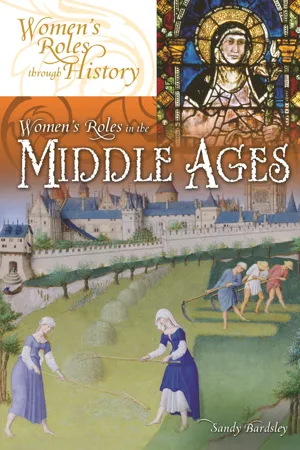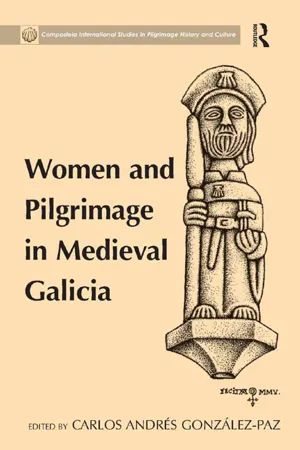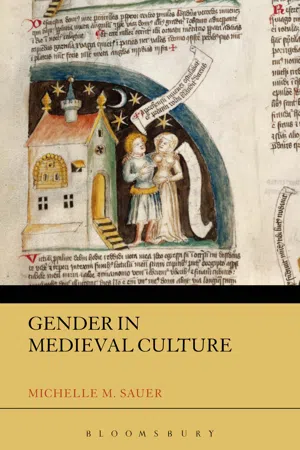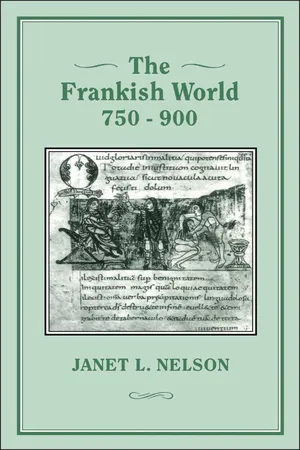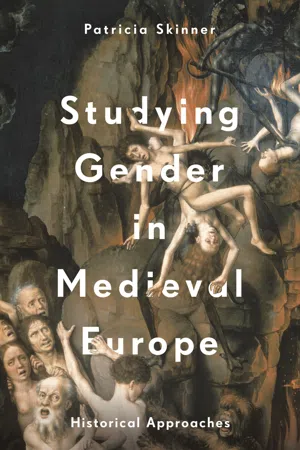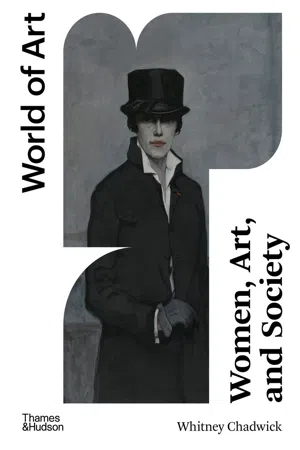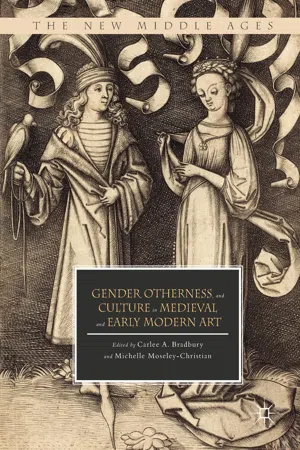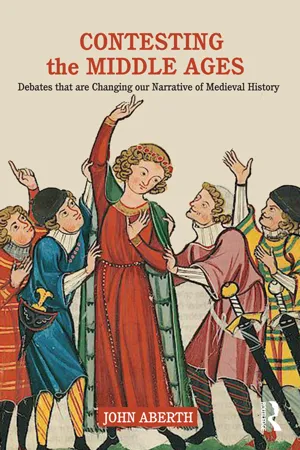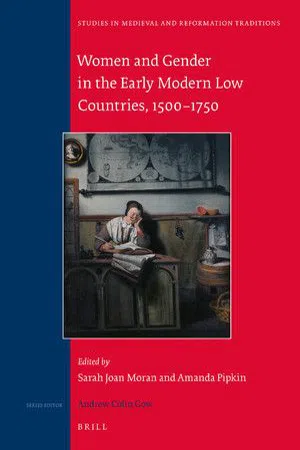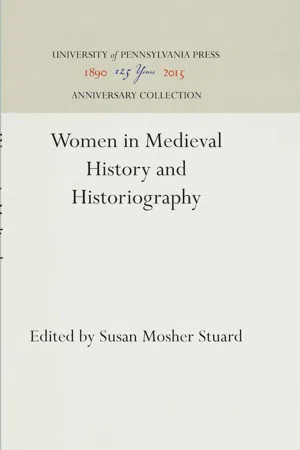History
Women in Medieval Times
Women in Medieval Times played diverse roles, including those of noblewomen, peasants, and religious figures. They were often expected to manage households, bear children, and support their husbands in their pursuits. While some women had limited rights and opportunities, others were able to wield significant influence and power within their communities.
Written by Perlego with AI-assistance
Related key terms
1 of 5
12 Key excerpts on "Women in Medieval Times"
- eBook - PDF
- Sandy Bardsley(Author)
- 2007(Publication Date)
- Greenwood(Publisher)
Introduction: Medieval Women Discussing medieval women as a group implies that they saw they had something in common. Yet chances were that a medieval noblewoman or a queen saw little, if any, connection between herself and a peasant woman, and that a Christian woman and a Jewish woman regarded themselves as having little in common. Medieval women were divided from one another in many ways: by their social class, their religion, their age, their marital sta- tus, and by the place and the period in which they lived. Yet, as historians look back at the experiences of medieval women, they cannot help but see common patterns that transcend barriers of class, religion, age, time, and place. Two patterns in particular emerge in this study of medieval women. First, women as a group were virtually always viewed as inferior to men as a group. In other words, medieval societies—like those that preceded and followed them—were patriarchal. Second, individual women could some- times overcome this inferior status and break the rules assigned to their sex. The fact that some women were able to break these rules did not, how- ever, mean that all women were able to do so. How did medieval women differ from one another? When a medieval person thought about his or her identity, class status may often have been more important than gender. The life of a medieval noblewoman was cer- tainly different from that of a nobleman in terms of work, responsibilities, and behavioral expectations, but it was arguably less different than the gap between a noblewoman and a peasant woman. Class changed over time and place, too: in some regions of Europe in the early Middle Ages, class distinctions were less entrenched. In later periods, people became acutely 2 Women’s Roles in the Middle Ages conscious of social class and strove to improve their families’ places in the social hierarchy. - eBook - ePub
- Carlos Andres Gonzalez-Paz(Author)
- 2016(Publication Date)
- Routledge(Publisher)
Chapter 1Women and the Christian Middle Ages The Theoretical Horizon María Isabel Pérez de Tudela VelascoGeneral Considerations
Any discussion of the position of women during the Middle Ages is a challenge that is as exciting as it is arduous. The developments in the study of the position of women in recent years have revealed the complexity of the question.1 It is not, therefore, excessive to assert that the ‘subject of women’ is one of the most difficult areas of the study of human history. Difficult because of the dearth of evidence and documents referring to women and the laconic style that characterises those examples that there are, but also because of the disparity between the cultural frameworks in which groups of women developed – and continue to develop – the roles assigned to them (or, using classical vocabulary, the charismas assigned to them). Complex too, because diverse circumstances caused each woman to draw on the powers and economic resources with which fate had provided her. These circumstances were and are increasingly determining as women were and continue to be much more limited in their initiatives than their male contemporaries.Undoubtedly, there are significant differences separating Christian and Jewish women, and also between them and Muslim women – and the same applied in the Middle Ages. Furthermore, then, the condition of younger women differed from that of elderly women, while the situation of married women was very different from that of consecrated women, and tangible boundaries separated wealthy and powerful women from those not possessing property and social resources. Daring and enterprising women may have enjoyed advantages over those who were fearful and pusillanimous but these are still to be determined. All these factors must be taken into account, quite apart from the fact that the dividing line most commonly used by those who studied and described medieval society from within (led by preachers and moralists) separated women into two groups: ‘honest’ women and ‘ignoble’ women. Among the first group were those who adapted their code of conduct to meet the dominant system of values, unlike the second group, who were not willing – or, in too many cases, were not able – to make such adjustments to their way of life. - eBook - ePub
- Michelle M. Sauer(Author)
- 2015(Publication Date)
- Bloomsbury Academic(Publisher)
CHAPTER FIVE The political sphere: Power, labor, and economics“One of the greatest constraints upon medieval women was economic,” write the editors of Sisters and Workers in the Middle Ages .1 Indeed, economic issues shaped the lives of women in the religious life as well as the secular, and men benefited from women’s lack of economic power. Feminist historians face some daunting challenges when looking into how economics affected gender roles. Barbara A. Hanawalt succinctly sums up the main issue—there are simply not very many records that reflect women’s involvement, both because of the time periods under study, and because women did not “count” under the law.2 By shifting the focus from “masculinist studies” of economic institutions to looking at actual production structures, such as guilds, and consumption issues, Theresa Earenfight suggests that we can deepen and expand our understanding of gendered power relationships and “social and cultural capital.”3 Moreover, we can shift our perspective of what it is we are looking for, as Christopher Cannon recommends, if we look at “the difficult process of the recording the life [of a medieval woman] . . . as the difficult process of living.”4 Thus legal theory about women, coupled with the lack of direct testimony can reveal another space in which we can address issues of gender. Similarly, lack of regulations regarding victualling and ale brewing may have provided easier access to women’s entrance into those economies.Working women challenged both gender roles and gender assumptions. Certainly, in any agrarian-based society, as medieval Europe decidedly was, all members of the household participate in the economic maintenance of the family unit. Wives were generally expected to oversee the daily aspects of living. On farms, this primarily meant housekeeping, food preparation and preservation, and household maintenance. Of these, food preparation and preservation was the most time-consuming. Cows had to be milked before cheese and butter could be made. Harvested grain was ground at the common mill, but bread needed to be prepared and baked daily. Animals had to be fed and watered. Eggs were gathered. Gardens were planted and weeded. Foods were dried, salted, or smoked for preservation. Flax and wool were soaked and spun into yarn and cloth. Village living was similar, except with fewer animal husbandry duties. In each of these cases, the women and men both toiled as a means of survival, and each was interdependent upon the other for success. Yet, despite the necessity of her contributions, the peasant woman was still subject to male control and ownership. - eBook - PDF
- Jinty Nelson(Author)
- 2010(Publication Date)
- Hambledon Continuum(Publisher)
9 What role could be more appropri-ate for women, placed as they were conveniently in the home? Call to mind some later medieval depictions of woman: of the Virgin Mary — consumer, in the solitude of her chamber, in private devotion, of the written word; devoted mother, sometimes also devoted daughter. The domestic detail puts woman in her place. But it also defines her space. Moreover, the woman in question may look like a peasant or a bourgeoise: can we infer a démocratisation, an extension to all women of the role hitherto played by noble ladies in fostering their spouses' virtue? This may be more than just a trick of the evidential light. There are more domestic interiors in later medieval art. 10 But it has been argued (I need only cite C.W. Bynum's exceptionally interesting book) that in the later middle ages women, poor servants as well as great ladies, took an active part in designing their own religious roles, not rejecting, but appropriating and exploiting, the gender stereotype that underpinned them. 11 I want to review some of the evidence for the religious activity of women in the earlier middle ages, and especially (though not exclusively) during the Carol-ingian period. For the immediately preceding Merovingian centuries, a good deal of recent work exists — though I may already have let slip my reservations about some of the patterns allegedly to be inferred from the available hagiographie and conciliar texts. For the tenth century, Karl Leyser's exem-plary account of Saxon convents has demonstrated how research on women can be integrated into the wider history of a particular society to illuminate its political workings as well as its religious priorities. 12 But there is a risk of some of his findings being generalised by others in misleading ways: from a Frankish criticisms of the general approach of much recent American historiography, see the review of Nichols and Shank byj. McClure in English Historical Review, 102 (1988), p. - eBook - ePub
Studying Gender in Medieval Europe
Historical Approaches
- Patricia Skinner(Author)
- 2018(Publication Date)
- Bloomsbury Academic(Publisher)
and modern society. And – as Virginia Woolf articulated so elegantly in 1929 – having ‘a room of one’s own’ was and is a still struggle. To these examples of social injustice we could add many more, and medieval historical research can strengthen and deepen movements of resistance.Campaigners for women’s rights in the 1970s and 1980s also focused on the dynamics of how power and knowledge were transferred between generations. Some female writers were held up as early champions of ‘feminism’ for pushing back against the misogynist ideas of their age, but attention also focused on women’sagency Ability to effect change for oneself or others, independently or collaboratively, their ability to grasp and hold onto power and influence through their actions or life cycle events such as marriage and motherhood. A focus on women and power emerged in feminist medieval history, and was championed by scholars such as Pauline Stafford, Janet Nelson (see Chapters 4 and 5 ), Suzanne Fonay Wemple and others. It may be no accident in Anglophone scholarship that considerable work was done on women and power during the decade following an era of powerful women leaders of the United Kingdom, India, Pakistan and Israel (whether this will be repeated in our own era, with women leading many more nation states, is yet to be seen). Rapidly, however, the focus changed to an emphasis on women’s power in relation to that of men, and the emergence of gender studies that explicitly offered a broader interpretation of power and emphasized itscontingency Reliant on other factors, not fixed. But whilst Joan Scott championed gender as a ‘useful category of analysis’, its very openness to interpretation provoked antipathy as well, as we shall see.A gendered reshaping of the medieval starts in Chapter 3 with recognizing the gendered understanding of the human body, and the ways in which authority is claimed over it. Monica Green has been at the forefront of examining women’s experiences of healthcare across a lengthy continuum, in particular the ways in which areas of medicine specific to women’s bodies, gynaecology and obstetrics (the field concerned with pregnancy and childbirth) became dominated by male medical practitioners and increasingly ‘medicalized’ between the medieval and early modern periods. Her work engages directly with the ways in which the life and health of the baby (representing the father’s living legacy) can often take precedence, still, over that of the mother, leading to invasive interventions in the birth by ‘professionals’. Men’s bodies, whilst not so prominent in a medical literature promoting fertility, feature more heavily in legal sources about interpersonal violence and injury, and the ‘maimed man’ might occupy a liminal place in his community. Also discussed is one of the most controversial (and thus stimulating) books published at the start of the 1980s, John Boswell’s Christianity, Social Tolerance and Homosexuality: Gay People in Western Europe from the Beginning of the Christian Era to the 14th Century - eBook - ePub
- Whitney Chadwick(Author)
- 2021(Publication Date)
- Thames and Hudson Ltd(Publisher)
13 ] Similar scenes—carved onto the capitals of Romanesque and Gothic churches, embroidered into tapestries, and painted with jewel-like precision in the borders of manuscripts—offer a diurnal counterpart to the sacred imagery of the Virgin Mary and Child that dominates medieval visual culture. Whether laboring in the service of God or for daily subsistence, the lives of most medieval men and women were organized around work. Although the names of a number of powerful women who were the patrons and benefactors of such representations are known today, we know little of the authors, for few of them signed their names and the preservation of their individual biographies had no role to play in their productions.The Christian Church, as the dominant force in Western medieval life, organized communication and culture, as well as religion and education. Assuming what Foucault called “the privileges of knowledge,” the Church exercised the religious and moral power which gave shape to human expression: “The need to take a direct part in spiritual life, in the work of salvation, in the truth which lies in the Book—all that was a struggle for a new subjectivity.” The Church’s hierarchical organization reinforced the class distinctions in society; its patriarchal dogma included a full set of theories on the natural inferiority of women which can be traced back to ancient Greece and the Old Testament. While medieval writers and thinkers discussed at length issues concerning women and their proper status in society, Christian representation was focused on the opposition of Eve and Mary, seducer and saint.Recent careful work by social historians has illuminated the ambiguous situation of women between the fourth and the fourteenth centuries. Scholars have demonstrated significant differences in men’s and women’s rights to possess and inherit property, in their duties to pay homage and taxes, their civil and legal rights, and their rights to present evidence or serve as judges or priests. The confusion of sovereignty with personal property (the fief) contributed to the emergence of a number of powerful upper-class women at a time when most other women were restricted to the home and economically dependent on fathers, husbands, brothers, or sovereigns. The rigidity of social divisions, and the gulf that separated upper and lower classes, meant that upper-class women had more in common with the men of their class than with peasant women. - Carlee A. Bradbury, Michelle Moseley-Christian, Carlee A. Bradbury, Michelle Moseley-Christian(Authors)
- 2017(Publication Date)
- Palgrave Macmillan(Publisher)
22 Because the fall of mankind in the Garden of Eden was enacted by Eve, the first woman, Christian exegetes held women to be inherently weak and evil, prey especially to temptations of the body. 23 Male-dominated institutions in the Middle Ages such as the church and the nobility often controlled the economic status of women and their pictorial representations, and so images of women can reflect socially created male attitudes towards them. 24 Some such images are misogynistic, marking women as “other” in the sense of being considered inferior to men and marginalized in dominant social structures like the church. 25 But art also suggests a more complicated view of women. Late medieval Christianity in western Europe centered on devotion to the Virgin Mary, for example, and cel- ebratory images of her proliferated, despite her female nature. 26 Exalted qualities like virginity elevated the status of certain women like Mary and female saints, making their behaviors that fell outside of traditional gender norms more acceptable. 27 Wealth also helped to elevate a wom- an’s status within society. As will be explained further below, wealthy women were regarded and depicted differently than the poor women shown as recipients of charity. The wealthy women who give charity were generally seen as generous and pious, while the poor women who are objects of such charity were portrayed as pitiable. By contrast, volun- tarily “poor” women who embraced poverty for religious reasons tend not to be shown as pitiable, but are instead celebrated as role models for 4 REPRESENTING WOMEN AND POVERTY IN LATE MEDIEVAL ART 73 all Christians. Economic and social status must therefore be considered alongside concepts of gender when interrogating images of an “other” such as the poor. INVOLUNTARILY POOR WOMEN AS RECIPIENTS OF CHARITY I will now turn to the portrayal of poor women as objects in scenes of charitable giving.- eBook - PDF
Rural Space in the Middle Ages and Early Modern Age
The Spatial Turn in Premodern Studies
- Albrecht Classen(Author)
- 2012(Publication Date)
- De Gruyter(Publisher)
Women of course occupied the central role in the household economy, child Ȭ care, cooking, brewing, washing, dairy work, gardening, care of poultry, etc., but women were also fully integrated into the web of life outside their door, visiting friends and relations, rendering labor services, traveling to markets, attending court, farming their land. In fact, women’s roles as actors and workers were more plastic, more flexible than men’s: all hands turned out for the harvest, but male brewers were comparatively few and far between in most villages before the Black Death. 31 So flexible was women’s work that in his study of medieval women and work in town and countryside, Jeremy Goldberg argues that women’s “work identity” tended to be fluid, indeed they lacked a “well Ȭ developed work identity” because they were “seldom wholly engaged in a single employment.” 32 Olwen Hufton has also observed that women “at the lower levels of society were remarkably adaptable over the issue of work,” taking “what they could as a source of income and adapt[ing] it to their life patterns and the rearing of their children.” 33 While there were important gender divisions in medieval farm work, women crossed the boundary into the traditional male sphere routinely, whereas men would only “cross over” in a crisis. Women’s “fluid work identity” may contribute to the problem of the general “invisibility” of women farmers, from the historian’s standpoint; but what it meant in village terms, whether it had a negative effect on women’s status, as Goldberg argues, is a point that deserves further study. Alternatively, that fluidity may have been one dimension of the “prominence” women once had which they have since lost, referred to by Stuard in the quotation above. - eBook - ePub
A History of the Girl
Formation, Education and Identity
- Mary O'Dowd, June Purvis, Mary O'Dowd, June Purvis(Authors)
- 2018(Publication Date)
- Palgrave Macmillan(Publisher)
adolescent girl, however, has led historians to focus more specifically on the different types of work undertaken by girls in towns as well as in the countryside.Medievalists and gender historians have begun to document girls working independently or on behalf of their familiar household, particularly in the fourteenth and fifteenth centuries in northern France and England . Girls’ access to independent employment seems to have been more difficult in southern Europe (with the notable exception of slaves or servants), where the application of Roman law tended to exclude them. Yet, as both textual and visual sources reveal, girls in most parts of medieval Europe worked with their fathers or brothers within the family workshop . Through an analysis of different types of sources, this chapter explores the role of girls and young women in urban workshops . There is a particular focus on girls engaged in paid artistic crafts, such as painting , embroidery , and work with gold or silver .Apprenticeship
Female apprentices appear in medieval London archives from the late thirteenth century. According to the laws of the City of London, a girl could be apprenticed to a woman or a man. For the female teenager, the period before marriage was one of freedom, and girls were aware of this independence and form of autonomy. Villagers came from the countryside to work in towns as servants or apprentices. Most young girls worked in small shops or as servants , seamstresses , laundresses , brewers , tapsters , or hostelers .5 Few secured skilled work, and most worked for short periods of time before they married. Domestic service allowed girls to leave the family home, save a little money for their marriage , and choose their husbands more freely. Some benevolent employers bequeathed small sums of money to their female servants, but wages were low for live-in servants , who were provided with lodging, clothing, and food.6 - eBook - ePub
Contesting the Middle Ages
Debates that are Changing our Narrative of Medieval History
- John Aberth(Author)
- 2018(Publication Date)
- Routledge(Publisher)
28 Rigby, “Gendering the Black Death,” p. 746.29 Shulamith Shahar, The Fourth Estate: A History of Women in the Middle Ages , trans. Chaya Galai (London: Routledge, 1983), p. 90; Judith M. Bennett, Women in the Medieval English Countryside: Gender and Household in Brigstock Before the Plague (Oxford: Oxford University Press, 1987), p. 103.30 Medieval Comic Tales , ed. Peter Rickard (Totowa, NJ.: Rowman and Littlefield, 1974), pp. 89–94.31 Edward Bliss Reed, English Lyrical Poetry from its Origins to the Present Time (New Haven, CT.: Yale University Press, 1914), p. 90.32 Reliquae Antiquae: Scraps from Ancient Manuscripts, Illustrating Chiefly Early English Literature and the English Language , eds. Thomas Wright and James Orchard Haliwell, 2 vols (London, 1841–42), 2:196–99.33 Roberta L. Krueger, “Towards Feminism: Christine de Pizan, Female Advocacy, and Women’s Textual Communities in the Late Middle Ages and Beyond,” in Oxford Handbook of Women and Gender , pp. 593–96. Christine is also famous for her Debate on the Romance of the Rose , in which she responded to misogynist elements in Jean de Meun’s poem.34 See Krueger, “Towards Feminism,” p. 596, n. 23, for scholarly works that criticize Christine as an ambiguous or contradictory feminist figure.35 Barbara Hanawalt has argued that medieval women were marginalized in terms of their physical space, i.e., being confined to the home or allowed out in public only under certain conditions. But her proof of this, that coroners’ inquests reveal greater percentages of women killed in private spaces such as houses compared to men, has been challenged on the grounds that such deaths only reflect the danger inherent in certain tasks, whether performed in public or private, and not the degree to which men or women spent time in such spaces. The extent of spatial marginalization of women also may have varied greatly by social status and regional customs. See: Barbara A. Hanawalt, “At the Margin of Women’s Space in Medieval Europe,” in Matrons and Marginal Women in Medieval Society , eds. Robert R. Edwards and Vickie Ziegler (Woodbridge, UK: Boydell and Brewer, 1995), pp. 8–9; Barbara A. Hanawalt, “Peasant Women’s Contribution to the Home Economy in Late Medieval England,” in Women and Work in Preindustrial Europe , pp. 7–10; P.J.P. Goldberg, “The Public and the Private: Women in the Pre-Plague Economy,” in Thirteenth Century England, III , eds. P.R. Coss and S.D. Lloyd (Woodbridge, UK: Boydell Press, 1991), pp. 75–89; Mate, Women in Medieval English Society , pp. 31–32; Sarah Rees Jones, “Public and Private Space and Gender in Medieval Europe,” in Oxford Handbook of Women and Gender - Sarah Moran, Amanda Pipkin(Authors)
- 2018(Publication Date)
- Brill(Publisher)
Yet, the terms of gender subordination have changed throughout history and did so as well during the late medieval and early modern period in Europe. Some scholars have explicitly addressed this issue by pointing out that any pa-triarchal regime is imbedded in – and ineluctably bound to – the larger po-litical, social, economic, or cultural order; it necessarily varies as that order varies. An article in Married Women and the Law , “Peasant Women, Agency, and Status,” for example, examined the marked dif ferences in peasant wom-en’s property rights and their legal status from region to region in medieval England, showing that some women possessed tenures and had access to courts in their own name, while others had no such status. The author of the study argued that these dif ferences reflected variations in manorial custom, landholding patterns, and economic structure. Thus the question of women’s status, she concluded, is not answerable by way of a study of the patriarchal structure alone but: … needs [in this instance] to be explored within the context of the feudal mode of production …. we need to try to understand gendered relation-ships within their specif ic local and manorial contexts … the structures underpinning oppression and inequalities change, and it is these struc-tures that need to be understood.13 Another article implicitly positioned the agency of a young Dutch woman in the religious culture of Dutch Calvinism. By independently seeking to per-suade her errant brother to leave the Jesuits and return to the Dutch Reformed Church, she appropriated for herself the paternal role.- eBook - PDF
- Susan Mosher Stuard(Author)
- 2016(Publication Date)
Yet, wc owe Germanic medi-evalists too much to complain too loudly: from them wc can learn the critical skills so necessary for interpreting the obscure documents of a re-mote past, and we can turn to their past publications for a wealth of infor-mation about medieval women. Women are a documented presence in the medieval histories produced by Germanic scholars, and we owe their pres-ence to the craftsmanship that distinguishes these histories. Notes 1. This essay owes a great deal to a preliminar)' draft begun by Suzanne Wemple of Barnard College. Although she was unable to complete the essay, Pro-fessor Wemple generously allowed me to use her work, and I have relied heavily on her expertise in several sections, above all in the discussions pertaining to women's legal status in the early and high Middle Ages and to marriage practices during these periods. 2. Two journals in The Netherlands are devoted to women's studies: Tijd-schrift voor vrouwen studies, now in its eighth year of publication, and the somewhat newer Jaarboek voor vrouwengeschiedents. 3. Humanists like Hartman Schedcl (d. 1514) and the Fuggers amassed col- 128 G E R M A N I C H I S T O R I O G R A P H Y lections of medieval annals. Eager to promote research on his Hapsburg ancestors, Emperor Maximilian supported the library at the University of Vienna. 4. As early as 1693, Gottfried Wilhelm von Leibniz (d. 1716) published the Codex juris gentium diplomaticus, following it with the Scriptores rerum Brunsvicen-sium (1701-11) and an annal covering the years 768 to 1005. His aide, Johann G. Eckhardt, subsequendy compiled and edited the Corpus historicum medii aeri ( 1723 ). 5. Quoted in Ernst Breisach, Historiography: Ancient, Medieval, and Modern (Chicago and London, 1983), p. 209. Part of the discussion in my historiographi-cal essay closely follows Breisach's narrative.
Index pages curate the most relevant extracts from our library of academic textbooks. They’ve been created using an in-house natural language model (NLM), each adding context and meaning to key research topics.
